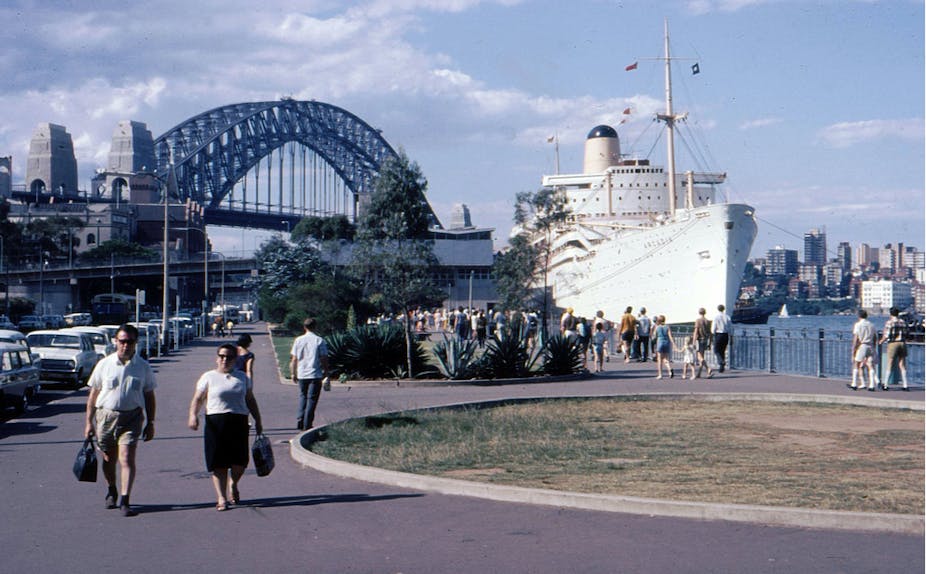Published biographies, and indeed many histories, are often about the famous, rich or powerful. And most often, they’re about men.
I’ve preferred to research and write about so-called “ordinary” men and women: private soldiers, postwar migrants, family women. These intimate, everyday histories connect to many readers, and show how we make our lives in historical circumstances which are not always of our own choosing.
In the decades after World War Two, women in Britain and Australia lived with - and sometimes against - a compelling expectation about women’s role: they should marry and devote their lives to suburban domesticity and childcare.
In Moving Stories: an intimate history of four women across two countries, the life stories of four women - Dorothy Wright, Gwen Good, Joan Pickett and Phyllis Cave - illuminate the rich and sometimes contradictory experience of the domestic ideal for women that was at the heart of the postwar suburban dream.
Beginning a new life
These four women were British migrants to Australia in the 1960s and 1970s. We know about their lives because they saved hundreds of letters and photographs they sent to family and friends back “home”, and later recorded their migration experiences in writing and oral history interviews.
Though migration is the connecting thread across these four lives, it’s not the central issue in Moving Stories. These women wanted to describe, compare and explain their new life in Australia.
They wrote in intimate detail and with acute sensitivity about aspects of Australian everyday life and women’s experience that are often lost to history: about childcare and housework, depression and joy, friendship, family and married life.
Their life stories recall the recent but easily forgotten history of women’s lives before the transformations led by feminists from the early 1970s.
A personal approach to history
Moving Stories is also a reflection on how historians can best use letters, photos and memories to make sense of the past and its potent resonance in the present.
Women were the primary correspondents in these migrant families, as they are in many families. What family functions were their letters performing? How did women use letters to make sense of migration and family life, and about themselves. What do their letters conceal as well as reveal?
Women also created family photo albums and sent photographs to relatives in England, and in so doing created visual representations of family life in Australia. What stories do the photo collections tell, what stories do they conceal, and what stories are lurking beneath the photographic surface only to be prompted into life through new remembering?
Dorothy’s story
Take Dorothy Wright who suffered terrible depression in 1961 after the birth of her second child in Sydney. Her husband was at work in the city and her family support was on the other side of the world; she was pulled between child care and housework; she was exhausted and bored by domestic life.
She wrote to her mother, “I’m not a good mother - not what Dr Spock calls a ‘slow mother’ who leaves her chores to make sure junior gets the right treatment. In fact, tho’ I love my 2 children, I just loathe the continual ‘hampered’ feeling.”
But Dorothy could not write home about her misery, and the photos she sent only depicted smiling babies and contented mothers.
The perspective of hindsight
Historians often prefer sources that are created close to the events, such as letters or photographs, and are wary of oral histories in which memory may be “tainted” by hindsight.
Yet Dorothy Wright was only able to write and talk about her depression after the event, and she only began to make sense of it later in life as new ideas emerged about post-natal depression and women’s roles, and she looked back on the difficulties of a young mother in the suburban 1960s.
The “Moving stories” of this book’s title is a play on words about different types of migration life stories.
Migrant letters, photos and memories narrate physical movement between places. They are redolent with the emotion of departure and separation, and are often deeply moving for the narrator and her audience.
And, like all life stories, these accounts are themselves constantly evolving and moving; they are living histories in every sense of the term. They are a source for women’s history, and in their creation we can read, see and hear the making and re-making of women’s identity, and the dynamic relationships between self and society, story and history.

